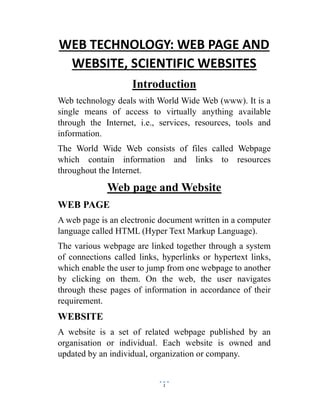
Web technology
- 1. 1 WEB TECHNOLOGY: WEB PAGE AND WEBSITE, SCIENTIFIC WEBSITES Introduction Web technology deals with World Wide Web (www). It is a single means of access to virtually anything available through the Internet, i.e., services, resources, tools and information. The World Wide Web consists of files called Webpage which contain information and links to resources throughout the Internet. Web page and Website WEB PAGE A web page is an electronic document written in a computer language called HTML (Hyper Text Markup Language). The various webpage are linked together through a system of connections called links, hyperlinks or hypertext links, which enable the user to jump from one webpage to another by clicking on them. On the web, the user navigates through these pages of information in accordance of their requirement. WEBSITE A website is a set of related webpage published by an organisation or individual. Each website is owned and updated by an individual, organization or company.
- 2. 2 The various elements of a website are:- 1. Home page: Home page or index page is the first screen or page of a site accessible through web. It provides an overview of what could be found at a website. 2. The other web pages which are linked to the Home page and can be accessed by simply clicking on their link (present on the Home page). ADDRESS OF A WEB PAGE Each web page has a unique address called Uniform Resource Locator (URL) that identifies its location on the web. For example, http://www.tomakewebsite.com/ opens the home page of the website. Types of Websites Websites can be categorised on various aspects. A. According to the purpose or function for which the website is designed:- 1. Business Websites: These are professional websites that are built purely for business reasons. They generally belong to an organisation, firm or company. They provide information about the company, its products, marketing schemes, etc. For example, www.intel.com, www.amazon.com 2. Informative Websites: These are built for the purpose of providing information. These include – a) News websites: For example, www.air.nic.in (Website of All India Radio).
- 3. 3 b) Science websites: For example, www.csirhrdg.res.in (Website for Council of Scientific and Industrial Research, India). c) Encyclopaedias: For example, www.britannica.com d) Websites giving analysis of some subject : For example, www.howstuffworks.com e) Medical information websites: For example, www.healthcare.gov f) Educational websites: For example, www.stanford.edu g) University/college/school websites: For example, www.mdsuajmer.ac.in 3. Search engines and directory type websites: Search engines search through entire web to find websites and list them on their servers. For example, www.google.co.in, dir.yahoo.com 4. Social networking and blogging websites: Social networking sites provide the user a facility to communicate with people anywhere in the world. For example, www.facebook.com. Blogging sites provide user a platform to express his/her views. For example, www.dearblogger.org B. According to the building method, i.e., based on the technology running the website:- 1. Static websites: These deliver static information to the user, i.e., information does not change over time and remains in the same form as sent by the web server. 2. Dynamic websites: These websites deliver dynamic information to the user, i.e., information that can
- 4. 4 change over time when sent to the user according to some criteria. Scientific Websites Today, the World Wide Web is indispensable for scientific research. Every scientist’s daily work includes searching the web for the latest literature as well as conducting scientific discourse via email. To fulfil such purposes scientific websites are created. The important features of a scientific website are:- 1. The design of web page is simple and clear, i.e., it is not confusing to the visitor. The various sections are clearly defined. 2. The home page of a scientific website is visually attractive and sometimes brightly coloured. Usually it has a picture gallery too (showing images of the achievements or research). 3. The content in scientific websites is usually supported with interesting and descriptive images. 4. The data about the organisation or institution and the various research papers or articles has authentication and is always up to date. 5. Usually a scientific websites have a well made, distinctive logo that helps in their easy recognition. 6. Most scientific websites have a menu displaying important topics. This helps the visitor to navigate the site easily.
- 5. 5 CATEGORISATION OF SCIENTIFIC WEBSITES The scientific websites can be categorised as under:- 1. Websites of various scientific organisations – These include: The websites of various governmental and non – governmental organisations working in the field of science and technology. For example, www.nasa.gov (the website of NASA), www.isro.org (the website of Indian Space Research Institute). The websites of various scientific societies. For example, www.indianchemsoc.org (Website of Indian Chemical Society) 2. Websites of various scientific newsletters and magazines– Worldwide many science magazines and newsletters are published. Most of these have their websites giving information about the contents of various editions. Some sites also provide the users with facilities like free account register for updates, signing up for reading selected content, etc. For examples, www.sciencemag.org (Website of Science magazine), www.downtoearth.org.in (Website of Down To Earth magazine). 3. Educational websites and websites of research institutions – These include: Websites providing various articles, projects, experiments and models related to science. For example, www.whfreeman.com
- 6. 6 Various research institutions globally have websites providing the enthusiasts updates of ongoing research in different streams. Such websites also provide information about the institute, its working environment and admission procedure. For example, www.tirf.res.in (Website of Tata Institute of Fundamental Research). 4. Commercial scientific websites – These are business websites, which include: Websites providing information about various scientific products and instruments. For example, www.merck.co.in, www.chinoindia.com Websites where the user can look for various subject related books. For example, www.springer.com References:- 1. Introduction to Information Technology, Pearson Education. 2. Learning to use the Internet; Ernest Ackermann. THANK YOU